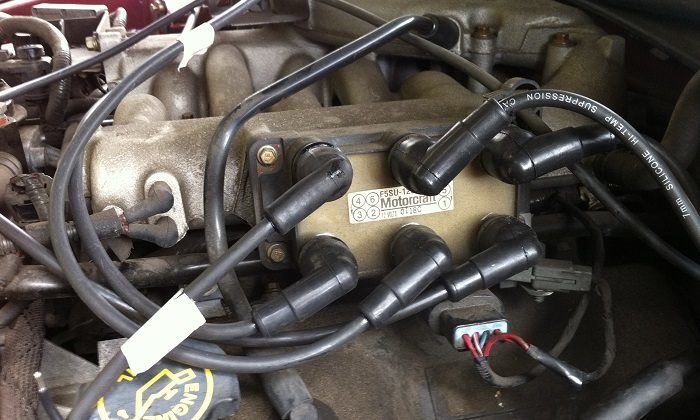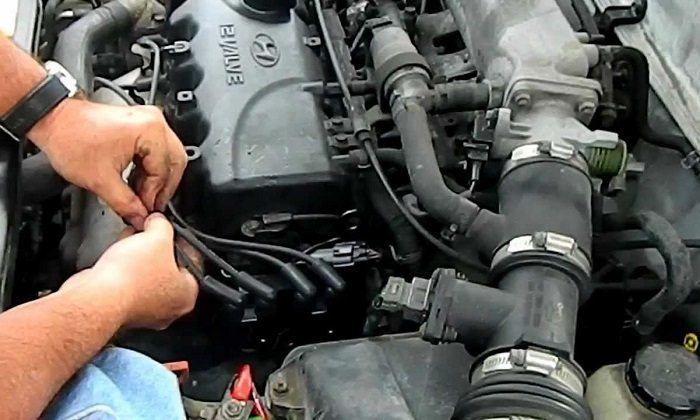by Joshua Thomas
There are certain components in the vehicle that look small and insignificant, but like everything else they play a crucial role and without them, you would probably not even be able to move the vehicle. One such component is the ignition coil.
The ignition coil is a type of transformer that is used for conversion and supply of adequate power to the spark plug to ensure it can create a spark and start your engine.
Given the essential role an ignition coil plays, in your car, if it is faulty the vehicle will not start. Hence, it is important to not only know how to handle the problem but also the symptoms to watch out for to be sure it is a faulty ignition coil and not a different issue.
Contents

Every spark plug in each cylinder will have a dedicated ignition coil that will be connected through wires or directly.
When the ignition coil is faulty, the most common sign will be a misfire that can easily cause problems to other components like the oxygen sensors and catalytic converters.
But, besides the misfires, there are also many other symptoms of a bad ignition coil, and below we highlight some of them.
Given the role that an ignition coil plays, it should be obvious that a problematic one will make it hard and sometimes even impossible to start the vehicle.
If the ignition coil is faulty, it often means the spark plug will not get the power it requires to create the spark needed to start your vehicle. And if they can make a spark it will be weak and you might need to turn the key several times to get the car started.
But, starting difficulties are not enough proof that you have a bad ignition coil as they can be caused by a wide variety of other issues from a bad starter to a flat battery.
When there are any issues in your engine such as a bad ignition coil, the check engine light will always come on. Hence, when the light comes on and you also notice one or more of the other symptoms in this list, then you need to have the ignition coil checked.
However, it is also worth keeping in mind that the light can come on due to many other issues and sometimes there is no problem with the vehicle at all and the computer is only misbehaving. Hence, this symptom should never be the only one you rely on to diagnose a bad ignition coil.
Read More: How to Reset Check Engine Light
For the modern vehicles, the ECU will compensate for issues like bad ignition coil to ensure that engine idling is always smooth. However, for older vehicle models, this is not the case. For these vehicles, rough idling can also be a symptom of a bad ignition coil.
When idling, the engine can also have a fluctuating speed or it can even keep dying instead of idling. Hence, to ensure smooth operation, you have to get the ignition coil checked immediately.
When you have a faulty ignition coil, you will most likely notice increased emission as it will indirectly affect the combustion of the fuel.
In many instances, hydrocarbon emission is what increases significantly, which might not look like a big deal but in places with strict emission laws, you can easily land in trouble.
Also, increased emission means that the fuel is not being burnt properly, which can affect the functioning of the engine, and in some instances even lead to more serious engine problems.
Because the fuel does not burn as it is supposed to when you have a bad ignition coil, you are also likely to experience exhaust backfiring.
Fuel particles will get to the exhaust pipe with higher energy than they would if the vehicle did not have any issues, and this energy is often released in the form of exhaust backfiring, which comes with some mini-explosions.
Exhaust backfiring will also result in black smoke being emitted from the exhaust pipe and also a lingering gas smell.
An ignition coil has to supply just the right amount of energy to the spark plug to ensure fast and efficient ignition. However, if the ignition coil is faulty, it will supply more power than required to the spark plugs, which often translates to the vehicle burning more fuel than usual.
And while the worsening fuel economy might not be very evident at first, over time you should start noticing your vehicle using up more and more fuel.
However, it is important to still inspect the vehicle to make sure no other issues are causing the bad fuel economy. Dirty engine filters and other issues like malfunctioning sensors will also often lead to bad fuel economy, and so you need to check them out first.

With the symptoms above in mind, you should now have an idea of how to tell when you have a bad ignition coil. However, it is still vital to know how to diagnose the problem just to be sure the ignition coil is faulty. And here are two ways to do this.
A spark tester provides a quick and easy way to test your ignition coil. And the good news is that besides the spark tester there is nothing more you need, and you will also not require any special skills. Also, you can buy one for just a few bucks.
Here are the few steps to follow.
Step 1: Switch off the engine and then disconnect the ignition coil from the spark plug.
Step 2: Connect spark tester to the coil output on one end and the other end to the spark plug.
Step 3: Now start the engine and check whether the spark tester light will flash. If the light flashes, it means the ignition coil is okay and if it does not, it means it is faulty.
Another relatively easy method of testing an ignition coil will entail using an OBD2 scanner, and this is even more useful if the check engine light comes on.
An OBD 2 scanner will give you the specific error code which you can use to determine whether the ignition coil is faulty or the engine has a different issue.
Here is what you need to do.
Step 1: Switch of the engine and connect the OBD 2 scanner on the vehicle's port (usually under the driver’s side of the dash)
Step 2: Now turn the key on to power the scanner.
Step 3: Press the scan button and allow the scanner to scan and display the error codes. The error codes displayed should let you know if you have a bad ignition coil.

Once you have ascertained that you have a bad ignition coil, now it is time to fix it. And here the best fix will be to replace the faulty one with a new one because there is hardly any permanent repair that can be done.
Also, it is possible to do the replacement on your own at home provided you have the right replacement part and tools.
Things You Need
Directions
Before you start working on the vehicle, you will first need to switch it off and allow it a few minutes for the engine to cool down to make it safe to work on. And once cooled down, you should disconnect the battery's negative terminal to ensure no power is still following through.
This step might require you to refer to your vehicle’s manual or do a quick online search if you are not sure how the ignition coil looks like. But, if you know how it looks, locating it should be easy as it will typically be attached to the engine block and placed on top of the engine.
Now you can go ahead and remove the faulty ignition coil, and for this, you will need to have the appropriate socket wrench. You should first disconnect the electrical connectors before you can remove the ignition coil.
But, your vehicle's manual should have more specific instructions on what to do here based on the specific ignition coil type or vehicle model.
Next, install the new ignition coil, and here you need to make sure that all the screws and bolts are tightened enough to ensure the unit works well.
And also remember to put back the electrical connectors to their original place, and make sure they are also tight enough because loose connections can be problematic.
The last step is to reconnect the battery terminal, and once this is done, you should take the vehicle for a spin to check whether everything is working well now.
If there are no misfires, stalling or difficulties starting the car and the check engine light is off, the vehicle is okay. But, if you still notice these issues, the only solution now will be to take the vehicles to the repair shop and have it checked by a professional mechanic.
Note: On average a bad ignition coil replacement will cost between $150 and $270 including labor. But, if you do it on your own, you can spend as little as $120 depending on the cost of the specific ignition coil for your vehicle as you will not need to pay any labor cost.
An ignition coil is vital for starting the vehicle and also ensuring they function smoothly, and so a bad or faulty one will affect your driving experience and affect how the vehicle functions greatly.
But, the good news is that this is still quite an easy problem to deal with. However, you first need to understand some of the symptoms to watch out for such as vehicle misfiring, stalling and check engine light coming on.
While some motorists will prefer to simply take their vehicle to the auto repair shop to have the problem fixed, you can still do it at home.
All you will need to do is first know how to diagnose the problem to be sure of what you are dealing with and then follow the simple steps above to replace the bad ignition coil.
Sources
 |
 |
 |
 |

About Joshua Thomas
Joshua Thomas just simply loves cars and willing to work on them whenever there's chance... sometimes for free.
He started CarCareTotal back in 2017 from the advices of total strangers who witnessed his amazing skills in car repairs here and there.
His goal with this creation is to help car owners better learn how to maintain and repair their cars; as such, the site would cover alot of areas: troubleshooting, product recommendations, tips & tricks.
Joshua received Bachelor of Science in Mechanical Engineering at San Diego State University.
Just Car Care